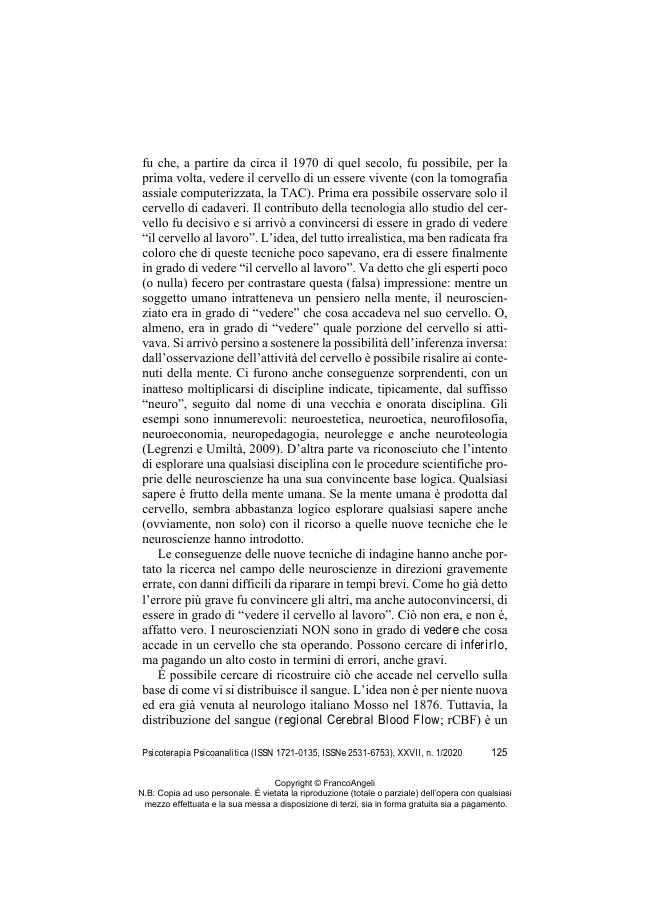Le neuroimmagini : il sogno tradito del "riduzionista"?
121-129 p.
Alla fine del XX secolo diventò possibile osservare la struttura di un cervello umano vivente e, pochi anni dopo, fu possibile osservarne an-che le attivazioni. Ne derivò la convinzione che fosse possibile osser-vare "il cervello al lavoro", "vedere", cioè, quali parti del cervello era-no attive mentre un soggetto aveva esperienza dei contenuti mentali. Ci si convinse, perciò, che si potesse accedere a quelle aree del cervello che producono la mente, "vederle mentre producono la mente". Pur-troppo, anche se si è convinti, come lo sono io, che la mente sia il prodotto del cervello, va riconosciuto che l'idea di essere attualmente in grado, attraverso le neuroimmagini, di "vedere il cervello al lavoro" è fuorviante. Per prima cosa, le neuroimmagini si basano sull'assunzione di "modularità". Sull'assunzione, cioè, che le funzioni mentali siano ascrivibli a specifiche aree cerebrali. Purtroppo, la modularità non è il solo modo plausibile di concepire il rapporto fra funzioni mentali e strutture cerebrali.
L'assunzione di modularità, poi, diventa utile soltanto se il ricercatore ha a disposizione strumenti per stabilire con precisione quali aree cerebrali sono attive mentre il soggetto sta svolgendo un compito. Le tecniche attuali non sono ancora in grado di farlo e molti sono i problemi irrisolti quando si interpretano le neuroimmagini. Un'altra difficoltà è che le caratteristiche del compito svolto dal sogget-to devono essere note nei dettagli. Invece, la natura delle operazioni che compongono una funzione mentale, e il loro decorso temporale, sono spesso ignote. Infine, anche assumendo che le altre condizioni siano ottemperate, si riuscirebbe semplicemente ad attribuire certe fun-zioni mentali a certe aree cerebrali. In altre parole, saremmo in grado di "localizzare" nel cervello le funzioni mentali. Purtroppo "localizzare" non vuole dire "spiegare".
Anche se fosse possibile attribuire certe funzioni mentali a certe aree cerebrali, il valore esplicativo di questa operazione sarebbe dubbio. Per spiegare una funzione mentale è di scarso aiuto sapere il luogo nel cervello dove viene realizzata. Una vera spiegazione richiede essere precisi e dettagliati riguardo ai meccani-smi dai quali dipende. [Testo dell'editore].
At the end of the 20th century, it became possible to observe the structure of a living human brain. Subsequently, observing its activa-tions became possible too. Because of that, it appeared that neuroscientists could see the "brain at work". They were able to "see" what parts of the brain were active while the subject was experiencing cer-tain mental contents. From there, the view originated that, through neu-roimages, we could have access to the areas of the brain that produced our mental life. Even if one is convinced, as I am, that the mind is a product of the brain, the notion that neuroimages allow us "to see the brain at work" is misleading. The first reason of skepticism is that neuroimages rest on the assumption of "modularity". This is the idea that mental functions are mapped "one-to-one" into brain areas. However, modularity is not the only plausible way of ascribing mental functions to brain areas.
Secondly, modularity becomes useful only on condition that the researcher possesses ways for determining with certainty what brain areas are active at a given moment. As of now, that is not yet the case. Also, the characteristics of the experimental task must be known in detail. This is not yet the case either: The nature of the operations that constitute a mental function and their time course are basically unknown. The most important reason of skepticism is that, even assum-ing that the conditions listed above are met, what we would have achieved is simply to map mental functions into brain areas. However, localizing does not mean explaining. Even if it were possible to map specific mental functions into well-localized brain areas (which is not yet the case) the explanatory value of localization would be doubtful. In order to explain why and how a given mental function occurs, knowing where in the brain it takes place is of little help.
A true explanation requires being precise and explicit about the mechanisms that cause that mental function. [Publisher's text].
Ist Teil von
Psicoterapia psicoanalitica : 1, 2020-
Artikel aus derselben Ausgabe (einzeln erhältlich)
-
Informationen
ISSN: 2531-6753
THEMENBEREICHE
KEYWORDS
- Neuroimmagini, cervello, mente, modularismo
- Neuroimages, brain, mind, modularity



